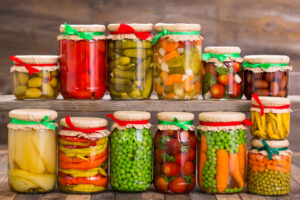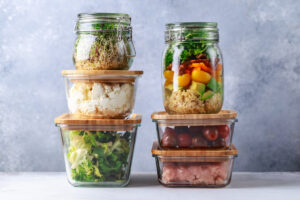Introduction

I will never forget the Christmas I made deviled eggs as part of my meal. Having a small kitchen and fridge I had no place to put them once I made them. Given the meal was only an hour away I felt comfortable it would be fine. Big mistake. Everyone who ate them got sick! As was only fitting I suppose I got the sickest! I literally had visions of the movie “Alien” and was sure a very ugly critter was going to burst from my stomach at any moment and at that point, I did not much care!
Short-term food storage and how to store food safely is a crucial aspect of maintaining the quality and safety of food items in our daily lives. It involves the temporary storage of perishable food items, such as fruits, vegetables, dairy products, and meats that typically last for a few days to a week. The primary goal is to keep food fresh, nutritious, and safe for consumption. Proper short-term food storage practices can help prevent foodborne illnesses, reduce food waste, and save money. This section provides an in-depth exploration of the various methods and safety measures associated with short-term food storage.

Also, it will save you from the embarrassment of having to explain to your family who may call, yes it was me. I’m the reason you are sick.
Definition and Importance of Short-Term Food Storage
Short-term food storage refers to the preservation of food that typically lasts from a few days to a few weeks. It is an essential practice in every household to maintain the freshness and quality of perishables like fruits, vegetables, dairy products, and meat. Short-term storage helps reduce food waste, saving money, and ensuring a consistent supply of healthy, fresh foods.
Overview of Safety Concerns: How to Store Food Safely
The importance of safety in short-term food storage cannot be overstated. Incorrect storage can lead to bacterial growth, causing foodborne illnesses. Key safety concerns include maintaining appropriate temperatures, as bacteria can multiply quickly if food is left too long at room temperature. Cross-contamination is another risk, where harmful bacteria from one food spread to another. Lastly, it’s crucial to always check expiry dates and consume food within its safe limit to avoid any health risks.
Here are some examples:
How long can you leave boiled eggs out safely?
Boiled eggs can be left at room temperature for up to two hours, however, it is recommended that they should be refrigerated within an hour. I suggest you follow that advice!
How long can you store milk in the refrigerator?
Milk can usually be stored safely in the refrigerator for up to one week after opening. However, it’s best to check the expiration date on the package to ensure its freshness.
Best Practices for Short-Term Food Storage
Here are a few best practices for short-term food storage:
- Store all foods at refrigerator temperature, typically between 34 and 40°F (or 1 to 4°C).
- Separate raw meat from other foods to prevent cross-contamination. This is true even if you are freezing.
- Keep food in airtight containers to avoid bacteria growth and spoilage.
- Label all stored foods with the date of storage, so you know which ones to consume first.
- Consume perishable goods as soon as possible and never store food past its expiration date.
- Store leftovers in the refrigerator for no longer than three to four days.
- Don’t leave leftovers out for longer than two hours.
- Be sure to wash your hands before and after handling food.
- When reheating food, always make sure it is heated through and piping hot before eating.
- Never defrost a food item at room temperature on the counter. The reason being the center may be frozen while the outside is warm enough to grow bacteria. It’s best to defrost in the fridge. But honestly, unless it’s a turkey I mostly don’t do this. But hey, I am the person that made my entire family sick so don’t listen to me.
- Take extra care with ready-to-eat foods such as pre-prepared sandwiches and salads, always checking for freshness or expiry dates. Nothing will make you sicker than a bad sandwhich from a vending machine!
- Keep an eye out for any signs of spoilage such as mold, discoloration or odors when inspecting food items.
- Finally, always follow the Food Safety Guidelines issued by your local health department.
Methods of Short-term Food Storage
Refrigeration is a fundamental method in short-term food storage, and it operates on a few basic principles. The primary function of a refrigerator is to extract heat from food items, thereby slowing down the bacteria growth that causes food to spoil. The cool temperature inside the fridge inhibits bacterial proliferation, extending the food’s shelf life.
There are several advantages associated with refrigeration. First and foremost, it significantly prolongs the freshness and edibility of perishable foods like dairy products, meats, and vegetables. This allows for greater flexibility in meal planning and reduces food waste. Secondly, refrigeration can help preserve the nutritional quality of the food, as certain vitamins and minerals are sensitive to heat and can degrade over time. Lastly, refrigeration is a safe and easy way to store leftovers, contributing to food safety in the home by preventing the growth of harmful bacteria.
Remember that the effectiveness of refrigeration in preserving food quality and safety depends on proper use, including adjusting the refrigerator’s temperature settings correctly (between 34 and 40°F or 1 to 4°C), covering food, and using airtight containers.
Other Methods of Food Storage
Beyond the fridge, other methods of short-term storage are available. Vacuum sealing is one way to keep food fresh for longer periods. When using a vacuum sealer, all air is removed from the package before it is sealed shut, preventing the growth of bacteria and molds while preserving freshness and flavor. This can help frozen food avoid freezer burn too.
For pantry items, airtight containers are great for keeping dry goods like flour, rice, and cereal fresh. For items with a more fragile nature — such as spices and herbs — glass jars are ideal because they keep out any moisture that could compromise the quality of the product.
Organization is key when it comes to storage solutions. Labeling containers and labeling shelves can be helpful in making sure everything has its place and is easier to find when it’s needed. Investing in stackable containers and countertop organizers can also be beneficial as they maximize space while keeping everything organized.
By taking the time to properly store food, you can preserve its quality, freshness, and safety for a longer period of time. This makes meal planning more convenient while reducing the likelihood of spoilage and wastage.
Counter Storage: Storing Food on Your Counter
Counter storage is another method of food storage that can be convenient and effective when done correctly. Certain fruits and vegetables, such as bananas, tomatoes, citrus fruits, and avocados, are best stored at room temperature on the counter, as refrigeration can affect their flavor and texture. Fresh herbs such as basil also do well on the counter in a glass of water, much like cut flowers.
Bread and pastries are other examples of foods that can be stored on the counter. They should be kept in a cool, dry place, ideally in a bread box or wrapped in a cloth to prevent them from going stale.
Although counter storage can be handy, some safety practices must be observed. Keep your counters clean and free from crumbs or spills that could attract pests. Ensure that food stored on the counter is not in direct sunlight, as this can accelerate spoilage. It’s also vital to use the food within a safe time frame and not allow it to sit out for extended periods.
Remember, the key to safe and effective counter storage is understanding the specific storage needs of different types of food and maintaining clean and secure storage conditions.
Storing food safely
It is important to store food safely in order to prevent the growth of bacteria and other microorganisms that can cause foodborne illnesses. To achieve this, it is necessary to understand and maintain appropriate temperatures for different types of food. Generally, cold foods should be stored at 40°F or below and hot foods at 140°F or higher.
When storing food in the refrigerator, it is important to ensure that the temperature remains consistent throughout, with no warm spots. Hot foods should be cooled quickly before being refrigerated, as bacteria can start to multiply if food is kept at temperatures between 40-140°F for too long.
Positioning of Food in Fridge
It’s also essential to store food appropriately in the refrigerator. Meat, poultry and seafood should always be stored on the bottom shelf, away from ready-to-eat items. This helps prevent any juices from raw foods from contaminating other foods when it comes into contact with them. Dairy products are best kept on a higher shelf, as they don’t produce any juices that could drip onto other foods.
Finally, it is important to ensure that food is stored in airtight containers or wrapped tightly in plastic or foil to prevent the growth of bacteria. This will help keep food fresh and safe for longer periods.
Used By and Best By Dates
To maximize food safety, it is important to pay attention to the used-by and best-before dates on food items. This helps ensure that you are eating food at its optimal quality and that it isn’t past its expiration date. Used-by dates refer to when a product should be consumed by to guarantee maximum freshness and quality; they are often found on dairy products, meat and ready-made meals. Best before dates refer to when food should be eaten by to maintain the highest quality; these labels can usually be found on tinned and packaged food items.
These dates do not mean the food id not edible. Just that it is not at it’s best.
Properly Handling Food
Once food has been bought and stored safely, it is important to handle it properly during cooking. Always ensure that you thoroughly wash your hands before handling any food, as doing so can help reduce the risk of contamination. It’s also a good idea to keep work surfaces and utensils clean and use separate chopping boards for raw meat, poultry and fish, as this can help ensure that bacteria isn’t spread to other foods.
When cooking food, it is important to make sure that it reaches the correct temperature before consuming. This helps to kill any harmful bacteria that may be present. Digital thermometers are a great way of ensuring that food has been cooked properly. Finally, make sure to serve food quickly after it has been cooked as this helps to prevent any bacteria from multiplying.
By following the tips above, we can help to ensure that food stays fresh and is handled safely while being stored, prepared and cooked. This will help us to enjoy edible meals safely and healthily.
Food Storage Containers for Short-Term Storage

Selecting the right type of food storage container can significantly impact the freshness and quality of food. Glass containers are an excellent choice for they are non-porous, meaning they will not absorb any food odor, color, or taste. They’re also typically oven-safe and dishwasher-safe, making them convenient for reheating and cleaning up.
Plastic containers, on the other hand, are lightweight and highly portable, making them ideal for lunch boxes or storing leftovers. However, it’s essential to choose ones that are BPA-free to avoid potential health risks.
Tin or metal containers, while not as common for short-term storage, are still a viable option, especially for dry goods such as grains or pasta. They offer a robust and durable solution but should be kept away from any moisture to prevent rusting.
Don’t use these or non-stick pans to store leftovers in fridge as they can leech chemicals into you food. Stainless steel is OK.
Each type has its advantages and choosing between them often boils down to the specific needs of the user.

Conclusion
In conclusion, it’s important to maintain good food safety habits when storing, cooking and consuming food. Selecting the right type of storage container can help keep food fresh and safe to consume. With these strategies in play, we can be sure that our meals will stay delicious and nutritious for as long as possible.
As an added advantage you won’t make your family sick as I did on that infamous Christmas! They have never let me forget it.
For more on food storage and preservation click here.
For more specific information on emergency food storage click here.
